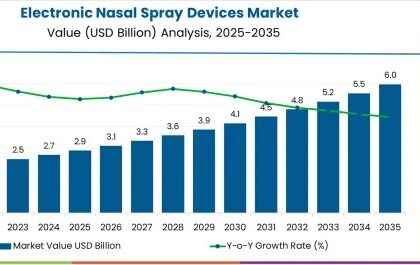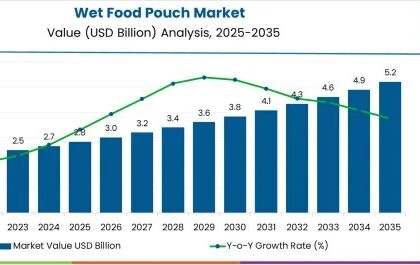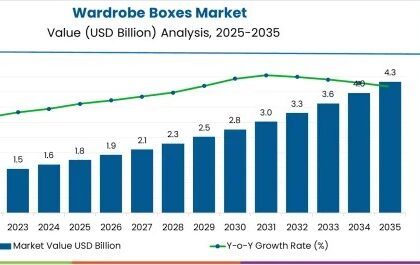
The global wireless healthcare asset management market is projected to grow rapidly from USD 52.06 billion in 2025 to USD 155.40 billion by 2035, registering a robust compound annual growth rate (CAGR) of 24.45% during the forecast period. This remarkable expansion is driven by healthcare institutions increasingly adopting wireless asset management solutions to improve operational efficiency, enhance patient safety, and mitigate risks related to equipment misplacement or loss. With the rising need for real-time visibility into the location, usage, and status of medical devices and supplies, hospitals and clinics are integrating smart tracking systems based on AI, Internet of Things (IoT), and cloud technologies.
The shift toward digitization and automation in healthcare operations is further fueling the demand for asset management systems capable of tracking inventory, reducing downtime, and ensuring regulatory compliance. Real-time location systems (RTLS) powered by wireless technologies are being used extensively to monitor assets such as infusion pumps, wheelchairs, defibrillators, and surgical tools. By streamlining equipment allocation and maintenance schedules, these systems contribute significantly to operational cost savings and improved patient care. Cloud-based asset management platforms enable seamless access to asset data across departments, while AI algorithms analyze usage patterns to predict maintenance needs and optimize resource utilization.
Get Ahead with Our Report: Request Your Sample Now!
https://www.futuremarketinsights.com/reports/sample/rep-gb-2298
Key Takeaways
The wireless healthcare asset management market is set to grow at an impressive CAGR of 24.45% from 2025 to 2035, reaching a valuation of USD 155.40 billion by the end of the forecast period. Key growth drivers include the increasing emphasis on patient safety, the reduction of healthcare-associated losses due to misplaced or underutilized assets, and the pressure on hospitals to improve workflow efficiencies. The adoption of RTLS, RFID (radio-frequency identification), and BLE (Bluetooth Low Energy) tracking technologies is helping healthcare providers achieve better inventory control and equipment lifecycle management. These technologies not only support day-to-day operations but also offer predictive capabilities that help facilities stay ahead of equipment failure or compliance issues. In addition, the rising focus on infection control and hygiene is encouraging hospitals to monitor the movement and sterilization cycles of critical medical devices in real time.
Emerging Trends in the Global Market
A major trend in the wireless healthcare asset management space is the convergence of wireless tracking systems with broader hospital information systems (HIS), electronic health records (EHR), and enterprise resource planning (ERP) platforms. This integration enables a unified view of asset usage, availability, and procurement across healthcare facilities. Moreover, the growing use of AI and machine learning algorithms is transforming asset data into actionable insights, enabling predictive maintenance, automated alerts for asset misplacement, and optimized usage analytics.
Another key trend is the rapid expansion of wireless tracking solutions in outpatient and remote care settings. With the rise of home-based healthcare and telemedicine, providers are using portable wireless sensors and trackers to monitor equipment used outside the hospital environment. In the context of aging populations and chronic disease management, ensuring the availability and proper functioning of medical assets in non-clinical settings is becoming increasingly critical. Furthermore, compliance with international standards for patient safety, such as Joint Commission accreditation, is encouraging healthcare providers to adopt smart asset tracking tools to meet documentation and audit requirements.
Significant Developments and Market Opportunities
The increasing complexity of healthcare environments is creating new opportunities for wireless asset management vendors to deliver tailored solutions for different types of medical institutions. From large multi-specialty hospitals to small clinics and specialty centers, there is a growing need for scalable systems that support real-time inventory, equipment usage analysis, and location tracking. Startups and tech innovators are developing mobile-first platforms that allow healthcare workers to scan, locate, and report asset conditions using smartphones and tablets.
In addition, the global focus on healthcare infrastructure development, particularly in emerging economies, is expected to boost adoption. Governments and private sector entities are investing in smart hospitals and digital healthcare projects where wireless asset management forms a foundational component of infrastructure modernization. With healthcare systems under pressure to improve capacity and reduce operational waste, asset tracking tools that enable better space utilization, maintenance scheduling, and cost forecasting are becoming indispensable.
Recent Developments in the Market
Recent years have seen a wave of strategic acquisitions and collaborations in the wireless healthcare asset management space. Established healthcare IT companies are acquiring niche tracking technology providers to broaden their capabilities in RTLS, RFID, and AI-based analytics. Cloud platform providers are also entering into partnerships with hospital networks to deliver end-to-end asset visibility through mobile apps, dashboards, and secure APIs. The adoption of wearable tracking tags for both equipment and personnel is gaining traction, helping hospitals not only locate assets but also manage staff safety and workflow optimization.
New product launches are increasingly focused on real-time dashboards, alert systems, and automated compliance reporting. These systems offer granular visibility into asset movement, downtime, and service histories, making it easier for administrators to take data-driven decisions. Moreover, cybersecurity is emerging as a crucial component of asset management platforms, especially with the proliferation of connected devices in healthcare facilities. Companies are enhancing their offerings with advanced encryption, role-based access controls, and compliance with data privacy regulations such as HIPAA and GDPR.
Exhaustive Market Report: A Complete Study
https://www.futuremarketinsights.com/reports/wireless-healthcare-asset-management-market
Competition Outlook
The wireless healthcare asset management market is characterized by the presence of both global technology giants and emerging players offering specialized tracking solutions. Leading companies include GE HealthCare, Siemens Healthineers, Zebra Technologies, CenTrak (a Halma company), Stanley Healthcare, Airista Flow, Ascom, Honeywell International Inc., Midmark Corporation, and IBM Corporation. These companies are competing based on innovation, integration capabilities, service reliability, and pricing models. Many of them offer modular solutions that can be tailored to various healthcare facility sizes and specialties, enabling broader market penetration.
As competition intensifies, providers are focusing on offering flexible pricing, easy-to-deploy systems, and value-added services such as predictive analytics and performance benchmarking. Partnerships with hospital groups, medical equipment manufacturers, and logistics providers are further expanding the ecosystem of wireless asset tracking. Companies that offer comprehensive, interoperable, and secure platforms with high user adoption rates are likely to dominate in the coming decade.
Key Segmentations
The wireless healthcare asset management market can be segmented based on technology, component, application, end-user, and geography. By technology, the market includes RFID, RTLS, Wi-Fi, Zigbee, and Bluetooth. Components are divided into hardware, software, and services. Applications range from equipment tracking and inventory management to staff tracking and temperature-sensitive asset monitoring. End-users include hospitals, long-term care centers, ambulatory surgical centers, and home healthcare providers. Regionally, North America holds the largest market share due to early adoption and healthcare digitization, while Asia-Pacific is projected to register the highest growth rate driven by infrastructure investments and government initiatives.
About Future Market Insights (FMI)
Future Market Insights, Inc. (ESOMAR certified, recipient of the Stevie Award, and a member of the Greater New York Chamber of Commerce) offers profound insights into the driving factors that are boosting demand in the market. FMI stands as the leading global provider of market intelligence, advisory services, consulting, and events for the Packaging, Food and Beverage, Consumer Technology, Healthcare, Industrial, and Chemicals markets. With a vast team of 400 analysts worldwide, FMI provides global, regional, and local expertise on diverse domains and industry trends across more than 110 countries.
Contact Us:
Future Market Insights Inc.
Christiana Corporate, 200 Continental Drive,
Suite 401, Newark, Delaware – 19713, USA
T: +1-845-579-5705
For Sales Enquiries: sales@futuremarketinsights.com
Website: https://www.futuremarketinsights.com
LinkedIn| Twitter| Blogs | YouTube




